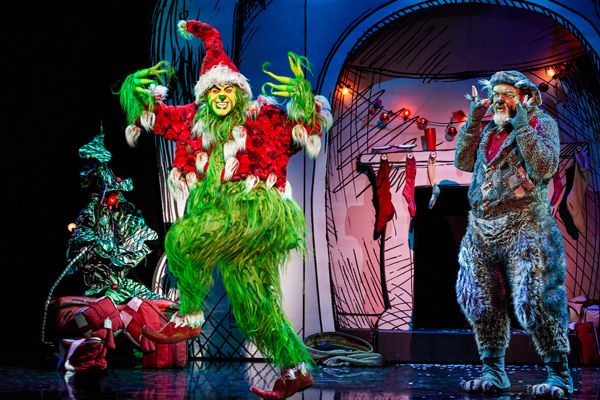Elizabeth Colomba Is Claiming Her Place in the History of Art
By Ilene Dube, JerseyArts.com
originally published: 04/13/2022
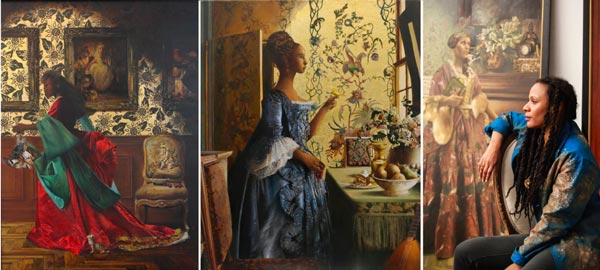
The France-born, Harlem-based artist was recently featured in Vogue; she was commissioned to create a painting for New York City’s Park Avenue Armory; she has a painting in an exhibition at the Metropolitan Museum of Art; and Princeton University has hung her first solo museum exhibition.
Elizabeth Colomba: Repainting the Story is on view at Princeton University Art Museum’s Art@Bainbridge through May 8. The exhibition showcases Colomba’s large canvases that place historical and fictional Black women, often richly dressed, in the opulent spaces from which they have been erased or in which they were assigned subservient roles. “Colomba liberates Black women from traditionally restrictive story lines to reclaim and celebrate their visual autonomy,” says Curator Laura M. Giles in exhibition materials.
“In addition to lavish costumes and opulent settings,” continues Giles, “Colomba employs motifs from classical mythology, cultural history, and religious narratives to empower her protagonists, thereby reclaiming for them, in her words, ‘an egalitarian existence in a story from which the Black body is almost always absent.’”
Giles, who is the museum’s Curator of Prints and Drawings, first learned about Colomba through a colleague and went to see an exhibition of hers in Harlem in 2016. There, she discovered the watercolor “Clytie,” and recommended it for a museum purchase. Anything that is a work on paper falls under her domain, Giles points out. The exhibition was built around the purchase.
In “Clytie” we see a light-skinned bejeweled Black woman dressed to the antebellum nines, weeping inconsolably, alongside a gilded mantel over which hangs a painting of a white-skinned male lyre player (although all we can see are his legs and the bottom of his robes and the gilded scrolls of his instrument). Clytie, Giles reminds those of us who are rusty on our mythology, was a water nymph in love with, and spurned by Helios, the god of the sun. “I’m being polite by saying that she was betrayed and abandoned,” says Giles, hinting at a possibly more brutal encounter. Clytie subsequently wasted away pining for Helios, according to the myth, and Helios transformed her, out of pity, into a flower that turns toward the sun.
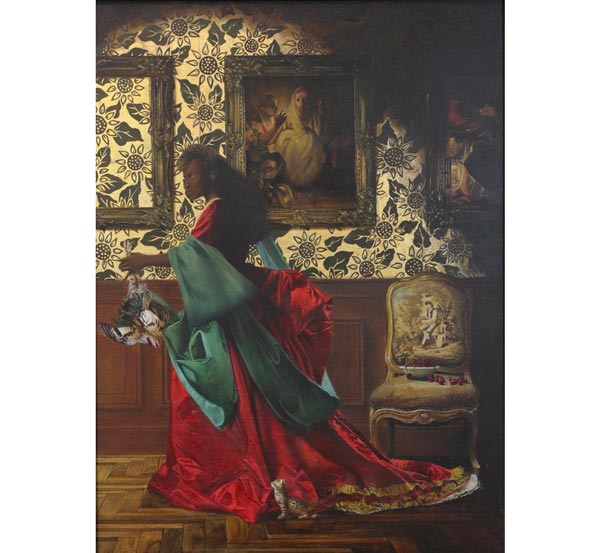
Elizabeth Colomba (born 1976, Épinay-sur-Seine, France; active New York, NY), Four Elements, Five Senses, 2018. Oil and gold leaf on canvas; 50.8 × 40.6 cm. Collection of Jennifer Hardy. Artwork © Elizabeth Colomba / Artists Rights Society (ARS), New York.
In addition to the yellow flowers in Clytie’s hair, we see sunflowers in a vase with draped figures on it, emerging from shrubs, one caressing a serpent-like figure, as Eros flies above holding a bow and a torch. Giles cleverly found, with help from a colleague, a replica of that very vase in the art museum’s collection. The 19th-century Wedgwood vase mimics an ancient Roman vase in the British museum and appears in a vitrine next to the painting. Because the art museum is closed for construction of the Sir David Adjaye-designed building on the existing footprint (Art@Bainbridge is one of two outposts in Princeton’s Palmer Square that continues to provide a physical presence for the museum), it was no small feat to get the vase out of storage.
But it was worth it. During a visit to see the exhibition, Colomba was pleasantly surprised to see the actual vase, recounts Giles. “To this day, the vase remains an enigma to scholars who haven’t figured out what the figures mean. Clytie is turning her back on the vase.”
Acquiring the works for the exhibition, all from private collections, required logistics and Giles was assisted by independent curator and writer Monique Long.
The four galleries of Art@Bainbridge are devoted to the themes Giles has conceived the exhibition around: mythology, allegory, history, and the feminine sacred, which Giles defines as the presence of women in religious stories.
“Her works are layered in meaning and reference earlier work in art history,” says Giles, who earned a Ph.D. in Italian Renaissance and Baroque Art from Harvard University, and was a curator at the Art Institute of Chicago before coming to Princeton in 2000. “There’s a lot to unpack in her work.”
Colomba’s painting of Eve, on view here, is unlike any other depictions of the biblical figure. Rather than in a garden, Eve – nude and draped with a satin sheet – sits on one of two mahogany sleigh beds covered with checkered blankets. A snake slithers between the two beds, and Eden is depicted in a painting within the painting, a still life overflowing with engorged cucumbers. “She also paints still lifes, but it was a curatorial decision to show the figures,” says Giles. “You rarely see Eve depicted on her own – (Albrecht) Dürer did two.”
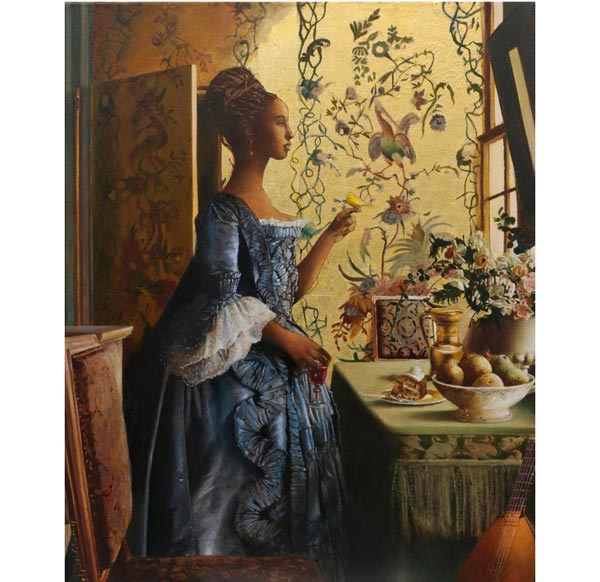
Elizabeth Colomba (born 1976, Épinay-sur-Seine, France; active New York, NY), Laure (Portrait of a Negress), 2018. Oil on canvas; 116.8 × 116.2 × 3.8 cm (frame). Private Collection. Artwork © Elizabeth Colomba / Artists Rights Society (ARS), New York.
One of Colomba’s more well-known paintings can be seen in the first gallery. “Laure (Portrait of a Negress)” takes the Black character from Edouard Manet’s “Olympia” – in which Laure is fully clothed and leaning into the reclining nude who is white (a painting, from 1868, said to have been scandalous in its day) – and places her on a cobblestone street on a rainy day, holding up a red parasol with one hand and her full ruffled skirts in the other. The scene evokes Gustave Caillebotte’s iconic 1877 painting “Rainy Day in Paris.” In Colomba’s version, Laure is an independent woman on her way to work as a model. Manet, who used Laure in other paintings, wrote in his notebook that she was a “très belle négresse” (very beautiful negress).
“I wanted Laure to be the star,” Colomba said in a video talk she gave for the Pennsylvania Academy of Fine Art (PAFA) last year. “I wanted her to be walking toward the viewer, as if we are passing her in the street. We are acknowledging her, which is not the case in ‘Olympia,’ where she’s just fading into the dark green background. I wanted her to take center stage.”
There is a black cat in Manet’s painting, which Colomba reimagines on the cobblestone street, and the bouquet Laure is holding over the nude in “Olympia” is, in Colomba’s painting, visible in the hands of a man in a carriage behind her. Perhaps, in the moment after this painting, Laure turns back to purchase the bouquet and bring it to her employer as a prop.
“I wanted to see what kind of status women at the time had,” Colomba said in the PAFA video. We see a “courtesan” (prostitute) off to the right, and a nanny tending two children in the distance. “This shows the status of women at the time – your career was very limited. You could be a wife; you could be a courtesan; or you could be a nanny. Laure was also a nanny in different portrayals of her. I wanted to paint her as a woman working for herself, posing for an artist, and being a part of Paris.”
Colomba, 46, who lives in Harlem, was born in 1976 in Épinay-sur-Seine, just outside of Paris, to parents who emigrated from Martinique and ran a Caribbean restaurant. She demonstrated prodigious gifts in both painting and language arts at an early age.
Studying traditional art-making techniques at the Estienne School in Paris, at the École des Beaux-Arts, Colomba also learned on her own at the Louvre, taking in the works of Dutch masters, among others.
But even early in Colomba’s career, she was aware of the paucity of women who looked like herself in painting and set out to redefine the role of Black figures in art. She wanted others to experience what she felt upon seeing the few examples she had seen.
“I wish to reshape the narratives and bend an association of ideas so that a Black individual in a period setting is no longer synonymous with subservience and, by extension, does not instill fear or mistrust,” Colomba writes on her website. “The subject becomes the center of her own story and hastens it forward.”
She came to the U.S. in 1998, first to Los Angeles where she worked as a storyboard illustrator for the film industry. (Giles points out that, even today, Colomba’s paintings are all about telling stories.)
Seeing a disconnect between the commercial work and her personal approach to making art, Colomba moved to New York in 2011. By 2016 Colomba had a solo show – the very exhibition Giles attended -- about which The New Yorker wrote of as “opulent portraits of black women [that] redress the erasures of women of color in nineteenth-century art history.”
The artist has made short films and a graphic novel (“Queenie,” worked on during the pandemic and released in France; the American edition is expected this year), but painting is what she comes back to. Her portrait of Minerva (the Roman goddess of wisdom, poetry, weaving, medicine, and strategic warfare, among others), commissioned by the Park Avenue Armory in New York, is, according to Colomba’s Instagram feed, the first work by a Black artist gracing that institution’s walls, “permanently promoting an inclusive view of the world. My heart is full… The lady now enthrones in the main hall. Come visit her, I hope she’ll inspire you.”
In her 22 years at the museum, Giles says she and her colleagues have made “robust” inroads in building the collection to be inclusive, including acquisitions of works by Elizabeth Catlett, Mario Moore, Titus Kaphar, Gordon Parks, and Colomba. “I gravitated to Elizabeth’s work because it is figurative, and both critical and admiring of the Western canon.”
RELATED EVENTS
April 14 @ 5:30pm EDT - Artist Conversation: Visual Storytelling and the Importance of Introspection. Artist Lashun Costor and Sarita Fellows, costume designer and lecturer in Theater at Princeton University, discuss Costor’s use of symbolism to create sculptures and wearable art that critique social and cultural issues in the United States.
April 21 @ 5:30pm EDT - Artist Conversation: Elizabeth Colomba and Autumn Womack. Artist Elizabeth Colomba and Autumn Womack, assistant professor of English and African American Studies at Princeton University, discuss the significance of Colomba’s portrayal of the eighteenth-century poet Phillis Wheatley.
April 28 @ 5:30pm EDT - Artist Conversation: Elizabeth Colomba and Jessica Bell Brown. Artist Elizabeth Colomba, and Jessica Bell Brown, curator for contemporary art at the Baltimore Museum of Art, discuss the process and meaning in Colomba’s multilayered narratives of historical and fictional Black women.
About the author: Driven by her love of the arts, and how it can make us better human beings, Ilene Dube has written for JerseyArts, Hyperallergic, WHYY Philadelphia, Sculpture Magazine, Princeton Magazine, U.S. 1, Huffington Post, the Princeton Packet, and many others. She has produced short documentaries on the arts of central New Jersey, as well as segments for State of the Arts, and has curated exhibitions at the Trenton City Museum at Ellarslie and Morven Museum in Princeton, among others. Her own artwork has garnered awards in regional exhibitions and her short stories have appeared in dozens of literary journals. A life-long practitioner of plant-based eating, she can be found stocking up on fresh veggies at the West Windsor Farmers Market.
Content provided by
Discover Jersey Arts, a project of the ArtPride New Jersey Foundation and New Jersey State Council on the Arts.
FEATURED EVENTS
Narrow results by date, categories, or region of New Jersey.
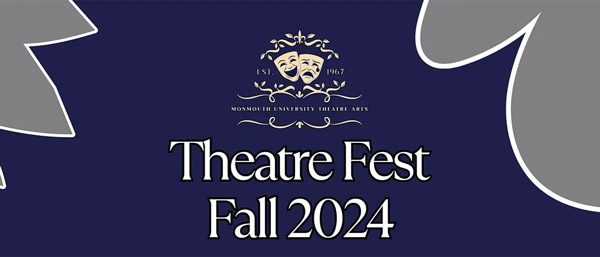
Theatre Fest Fall 2024 – Alpha Psi Omega Presents: To Be or Not to Be: Hamlet, an Abridged Staging
Saturday, November 23, 2024 @ 8:00pm
Monmouth University - Lauren K. Woods Theatre
370 Cedar Avenue, West Long Branch, NJ 07764
category: theatre
View event page for full information

Harry Potter and the Cursed Child (HS Edition)
Saturday, November 23, 2024 @ 7:00pm
Grunin Center
1 College Drive, Toms River, NJ 08754
category: theatre
View event page for full information

Harry Potter and the Cursed Child (HS Edition)
Saturday, November 23, 2024 @ 1:00pm
Grunin Center
1 College Drive, Toms River, NJ 08754
category: theatre
View event page for full information
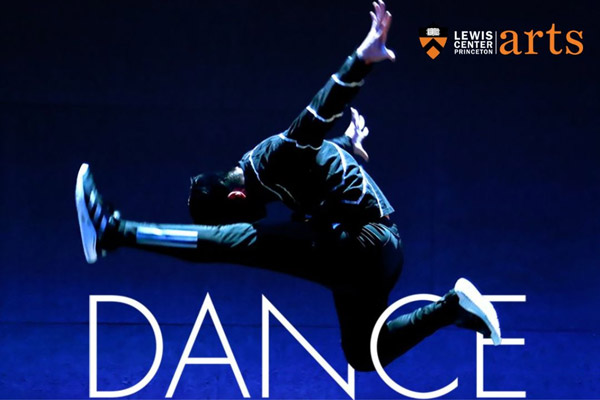
2024 Princeton Dance Festival
Saturday, November 23, 2024 @ 8:00pm
McCarter Theatre Center (Berlind Theatre)
91 University Place, Princeton, NJ 08540
category: dance
View event page for full information

2024 Princeton Dance Festival
Saturday, November 23, 2024 @ 2:00pm
McCarter Theatre Center (Berlind Theatre)
91 University Place, Princeton, NJ 08540
category: dance
View event page for full information
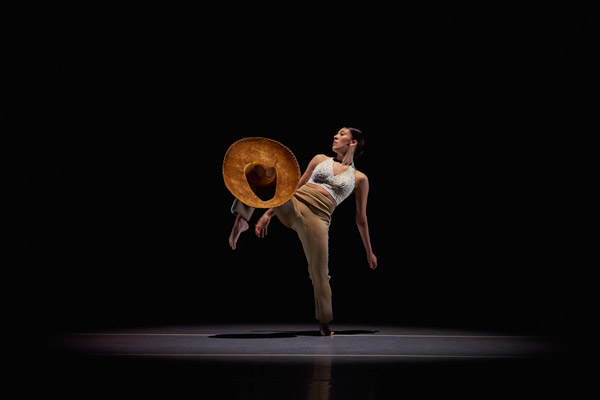
Fall Dance Plus
Saturday, November 23, 2024 @ 7:30pm
New Brunswick Performing Arts Center (NBPAC)
11 Livingston Avenue, New Brunswick, NJ 08901
category: dance
View event page for full information

Axelrod Performing Arts Academy presents Disney's "Alice in Wonderland, Jr."
Saturday, November 23, 2024 @ 7:00pm
Bell Theater
101 Crawfords Corner Road, Holmdel, NJ 07733
category: theatre
View event page for full information

Axelrod Performing Arts Academy presents Disney's "Alice in Wonderland, Jr."
Saturday, November 23, 2024 @ 3:00pm
Bell Theater
101 Crawfords Corner Road, Holmdel, NJ 07733
category: theatre
View event page for full information

HAPPY FRANKS-GIVING! – Swingtime Big Band Celebrates Sinatra
Saturday, November 23, 2024 @ 8:00pm
Bergen Performing Arts Center (bergenPAC)
30 North Van Brunt Street, Englewood, NJ 07631
category: music
View event page for full information

Elf The Musical
Saturday, November 23, 2024 @ 7:00pm
Count Basie Center for the Arts
99 Monmouth Street, Red Bank, NJ 07701
category: theatre
View event page for full information

Elf The Musical
Saturday, November 23, 2024 @ 1:00pm
Count Basie Center for the Arts
99 Monmouth Street, Red Bank, NJ 07701
category: theatre
View event page for full information
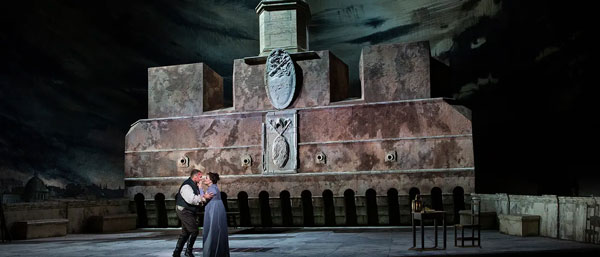
The Metropolitan Opera: Live in HD - Tosca
Saturday, November 23, 2024 @ 1:00pm
Monmouth University - Pollak Theatre
400 Cedar Avenue, West Long Branch, NJ 07764
category: theatre
View event page for full information

StevieMac: A Fleetwood Mac & Stevie Nicks Experience
Saturday, November 23, 2024 @ 8:00pm
William Paterson University - Shea Center for Performing Arts
300 Pompton Rd, Wayne, NJ 07470
category: music
View event page for full information
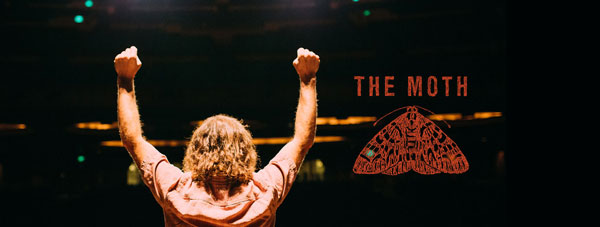
The Moth
Saturday, November 23, 2024 @ 7:30pm
McCarter Theatre Center (Matthews Theater)
91 University Place, Princeton, NJ 08540
category: community
View event page for full information

Dr. Seuss' How The Grinch Stole Christmas! The Musical
Saturday, November 23, 2024 @ 7:30pm
State Theatre New Jersey
15 Livingston Avenue, New Brunswick, NJ 08901
category: theatre
View event page for full information

Dr. Seuss' How The Grinch Stole Christmas! The Musical
Saturday, November 23, 2024 @ 3:00pm
State Theatre New Jersey
15 Livingston Avenue, New Brunswick, NJ 08901
category: theatre
View event page for full information

Dr. Seuss' How The Grinch Stole Christmas! The Musical
Saturday, November 23, 2024 @ 10:30am
State Theatre New Jersey
15 Livingston Avenue, New Brunswick, NJ 08901
category: theatre
View event page for full information

Wooden Ships Band
Saturday, November 23, 2024 @ 7:30pm
Lizzie Rose Music Room
217 E. Main Street, Tuckerton, NJ 08087
category: music
View event page for full information
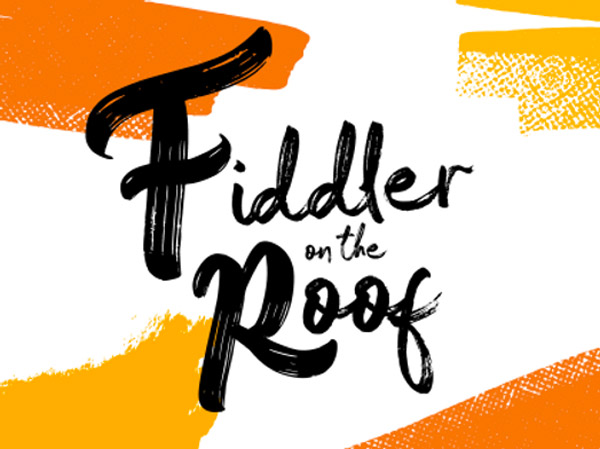
Fiddler On The Roof
Saturday, November 23, 2024 @ 7:30pm
Axelrod Performing Arts Center
100 Grant Avenue, Deal Park, NJ 07723
category: theatre
View event page for full information

Fiddler On The Roof
Saturday, November 23, 2024 @ 1:30pm
Axelrod Performing Arts Center
100 Grant Avenue, Deal Park, NJ 07723
category: theatre
View event page for full information
More events
Event Listings are available for $10 and included with our banner ad packages
EVENT PREVIEWS

American Dream Announces Holiday Plans
(EAST RUTHERFORD, NJ) -- American Dream invites guests to spend the holidays at the one-of-a-kind center, as it transforms into a winter wonderland showcasing the very best in retail, dining and entertainment. Throughout the season, American Dream will be giving away incredible prizes, creating lasting memories and spreading joy throughout the community.
UPCOMING EVENTS
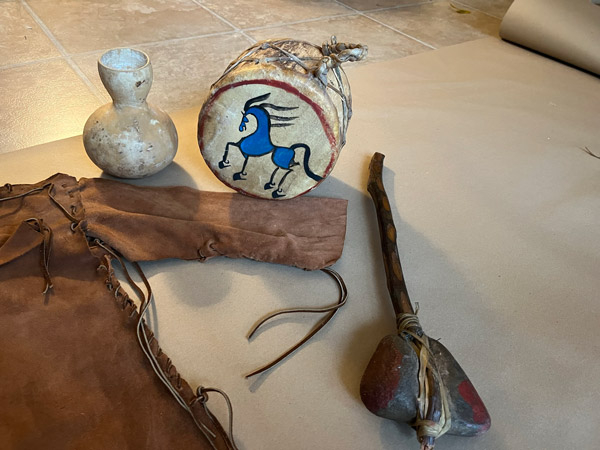
South Jersey's Indigenous Communities Celebrated in New A.C. Arts Garage Exhibit
(ATLANTIC CITY, NJ) -- A new exhibit at the Noyes Arts Garage of Stockton University will celebrate two southern New Jersey tribal communities through the display of historical documents, traditional artifacts and contemporary art. "Still Here: The Nanticoke Lenni-Lenape and Powhatan-Renape Nations of Southern New Jersey" opens October 9 and runs until January 5, 2025.





















